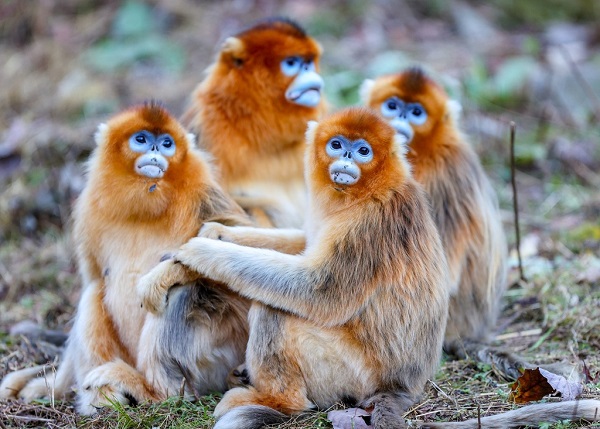BLOG POST 5
Special Topic: Vocal communications in regards to location, familiarity, and food abundance
PEER-REVIWED ARTICLE REVIEW
Article Summary & Findings:
This study investigates the vocal and movement responses of mantled howler monkeys (Alouatta palliata) to loud calls from neighboring groups. The study was conducted in the La Flor de Catemaco forest in Veracruz, Mexico, from January 2016 to March 2017, and the research explored how these responses are influenced by things like familiarity with the caller, food availability, and the distance between groups. The study involved three groups of howler monkeys, with varying levels of familiarity between each other. There were the long-term residents (G1 and G2) and a short-term resident group (G3). Researchers recorded loud calls and the corresponding vocal and movement responses of the receiving groups. The Data analysis mainly focused on how these responses varied in relation to the three mentioned factors food availability, familiarity, and distance. Looking into the positive or negative relationships that exist in these scenarios and whether howler monkeys took these factors into consideration for appropriate action of calls. The study applied statistical techniques to observational data to model these relationships and see the influence environmental and social factors may drive in the behavioral responses of the howler monkeys, as well as reveal any nuances to these interactions.
The research revealed that the familiarity between groups played a major role in how the receiving groups responded to loud calls. Groups vocalized more quickly and for longer periods when responding to unfamiliar neighbors. The distance between groups also affected the duration of the response. A closer distance in call results in longer vocal and movement responses. Interestingly, the study found no significant effect of food availability on vocal or movement responses. Though when food availability was recognized as low, groups still ended up producing those longer vocal responses when they were encountering unfamiliar neighbors, especially nearby. The direction of movement was also influenced by distance as well. Groups were much more likely to retreat from closer neighbors. Which again strongly supports that howler monkeys use loud calls to communicate territorial boundaries with the indication that stronger reactions are used toward unfamiliar neighbors to prevent conflicts.
Figure 1
Application to Alouatta seniculus
These insights can very much be applied to Alouatta seniculus. Both species exhibit complex vocal communication systems and share similar ecological niches and social dynamics. In both species, vocalizations play a key role in intergroup interactions, serving to define territory and communicate group identity and locations. The strong vocal responses to unfamiliar neighbors observed in A. palliata can likely be seen in A. seniculus, as both species often inhabit overlapping home ranges and interact with neighboring groups in similar ways. These interactions definitely influence their social structures, especially in how they manage competition for resources or defend territories.
What this means for Alouatta Biology, Ecology, and Behavioral
This research solidifies several foundational traits of the Alouatta genus and adds layers by highlighting nuances that occur when social, spatial and food factors come into play in actions and decision making for howler monkeys. First, it reinforces the genus’s reliance on vocalization as a low-cost strategy for managing intergroup conflict and "negotiating" territory. The fact that response strength varies with caller familiarity and proximity is exemplary of the cognitive complexity behind receiving, determining meaning, and responding accordingly to these calls, pushing a higher level of social awareness that contributes to territorial cohesion and group stability. Ecologically, the study highlights how Alouatta species use vocal behavior to navigate patchy or seasonally variable food landscapes without resorting to direct confrontation. Biologically, the differentiated responses to familiar vs. unfamiliar groups also point to the importance of long-term social memory and recognition in shaping how groups perceive and respond to threats or competition. Altogether, the research expands our understanding of how ecological pressures and social relationships co-shape Alouatta group dynamics, reinforcing the genus’s reputation as behaviorally sophisticated, ecologically adaptable, and socially strategic.
Figure 3
Figure 2
Analysis of Findings
The study provides valuable insights into the vocal and movement responses of howler monkeys to loud calls, especially the role of familiarity in these interactions. However, the lack of significant correlation between food availability and vocal responses challenges some earlier assumptions that resource competition plays a direct role in intergroup interactions. This could lead to a reevaluation of how food scarcity influences social behavior in primates, particularly in species like A. seniculus that face fluctuating resource availability. The study also contributes to the broader understanding of the "dear enemy" effect, where neighboring groups with which there is mutual familiarity are less likely to engage in aggressive behaviors. The behavioral responses observed in this study might prompt further research on how familiarity and resource availability interact to shape primate social dynamics. Future studies could explore how these interactions vary across different habitats and under varying ecological pressures, adding depth to our understanding of primate territoriality.
References
Fortes, V. B., Bicca-Marques, J. C., Urbani, B., Fernández, V. A., & da Silva Pereira, T. (2014a).
Ranging behavior and spatial cognition of Howler Monkeys. Howler Monkeys, 219–255.
https://doi.org/10.1007/978-1-4939-1960-4_9
Fortes, V. (2014). Figure 1. Retrieved 2025,.
Fortes, V. (2014). Figure 2. Retrieved 2025,.
Fortes, V. (2014). Figure 3. Retrieved 2025,.



Comments
Post a Comment